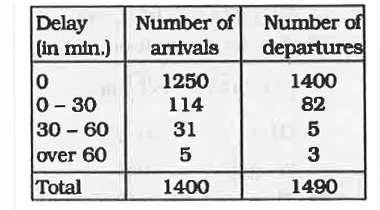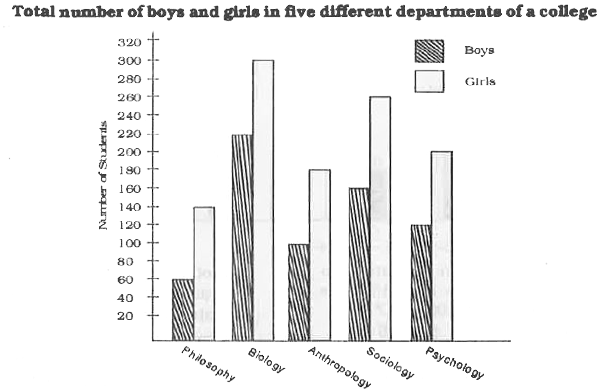If the punctuality of railways is defined as the number of occasions onwhich trains arrived or departed in time as a percentage of total number of arrivals and departures from the station, then the punctuality for the month under observation is
94.3%
91.7%
89.2%
75%
The correct Answer is:B
To calculate the punctuality of the railways based on the given information, we will follow these steps:
Step 1: Identify the Data
We need to gather the number of trains that arrived and departed on time (0 minutes delay) and the total number of trains that arrived and departed.
- Trains on time (0 minutes delay):
- Arrivals: 1250
- Departures: 1400
- Total trains:
- Total arrivals: 1400
- Total departures: 1490
Step 2: Calculate Total On-Time Trains
Add the number of trains that arrived on time and the number of trains that departed on time.
Total On-Time Trains=Arrivals on time+Departures on time=1250+1400=2650
Step 3: Calculate Total Trains
Add the total number of arrivals and departures to find the total number of trains.
Total Trains=Total Arrivals+Total Departures=1400+1490=2890
Step 4: Calculate Punctuality Percentage
Now, we can calculate the punctuality percentage using the formula:
Punctuality Percentage=(Total On-Time TrainsTotal Trains)×100
Substituting the values we calculated:
Punctuality Percentage=(26502890)×100
Step 5: Perform the Division
Calculate the division:
26502890≈0.9169
Step 6: Convert to Percentage
Now, convert this decimal to a percentage:
0.9169×100≈91.69%
Step 7: Round the Result
Round the result to one decimal place:
Punctuality Percentage≈91.7%
Final Result
The punctuality for the month under observation is approximately 91.7%.
---
We need to gather the number of trains that arrived and departed on time (0 minutes delay) and the total number of trains that arrived and departed.
- Arrivals: 1250
- Departures: 1400
- Total arrivals: 1400
- Total departures: 1490
Add the number of trains that arrived on time and the number of trains that departed on time.
Add the total number of arrivals and departures to find the total number of trains.
Now, we can calculate the punctuality percentage using the formula:
Calculate the division:
Now, convert this decimal to a percentage:
Round the result to one decimal place:
The punctuality for the month under observation is approximately 91.7%.
Topper's Solved these Questions
- DATA TABLE BOOK - ARIHANT SSCCHAPTER - DATA TABLE EXERCISE - HIGHER SKILL LEVEL QUESTIONS
25 Videos
- DATA TABLE BOOK - ARIHANT SSCCHAPTER - DATA TABLE EXERCISE - HIGHER SKILL LEVEL QUESTIONS
25 Videos
- DATA SUFFICIENCYBOOK - ARIHANT SSCCHAPTER - DATA SUFFICIENCYEXERCISE - FAST TRACK PRACTICE
30 Videos
- DISCOUNTBOOK - ARIHANT SSCCHAPTER - DISCOUNTEXERCISE - FAST TRACK PRACTICE
47 Videos
Similar Questions
Table below shows the one a railway station according to a survey done in the month of January in year 2000. Study the table and answer the following questions:

If time accuracy of railway is defined on Percentage of number of trains arriving and departing on time on a railway station to the total no.of trains arriving and departing on that railway station. Then what is time accuracy of railway in the month of survey?
View SolutionDirection: Study the following information carefully and answer the question based on it. In a coded language !, @, #, $, %, ^ are represented by 2, 12, 6, 3, 1 and 5 respectively.
When any two symbols are used together then one of them represents the number at which hour hand ispositioned and other represents the number at which minute hand is positioned in a clock.Consider all-time at pm.
Two trains A and B are scheduled to arrive at same time, train A is ## hours late and train B is running %% hours late than the scheduled time. What is the difference in the time of arrival of both the trains?
View Solution
Knowledge Check
The table given below shows survey carried out at a railway station for the arrivals/departures of trains for the month of January, 2000. Study the table and answer the following questions.

If the punctuality of railways is defined as the number of occasions on which trains arrived and departed in time as a percentage of total number of arrivals and departures from the station, then the punctuality for the month under observation isA94.3%B91.7%C89.2%D75%The percentage of number of trains arriving late at the station is
A6%B10.4%C10.7%D10.9%The total number of late arrivals of trains is
A90B95C145D150
Study the bar diagram and answer the questions.

The percentage of the girls from Biology Department compared to the total number of girls from all the other Departments together is
View SolutionStudy the bar diagram and answer the questions.

The percentage of the boys from Biology Department compared to the total number of boys from all the other Departments together is
View SolutionEarthquakes generate sound waves inside the earth. In case of the earth, both transverse (S) and longitudinal (P) waves can propagate. Typically, the speed of S waves is about 4.5 km s−1 and that of P waves is 8.0 km s−1. A seismograph records both P and S waves from an earthquake. this difference helps us to find the distanec of the point of origin of the earthquake. this point is called the epicenter.
Q. The reading of the time lag between the arrival of S and P waves gives us the distance of the epicenter from the location of a seismograph. the readings of what minimum number of seismographs would be necessary to pinpoint the location of an epicenter?
View SolutionThe table given below shows survey carried out at a railway station for the arrivals/departures of trains for the month of January, 2000. Study the table and answer the following questions.

The percentage of number of trains arriving late at the station is :
View SolutionAn engineer works at a factory out os town. A car is sent for him from the factory every day and arrives at the railway station at the same time as the train. One day the engineer arrived at the station one our before his usual time and without waiting for the car, started walking towards factory. On his way he met the car and reached his factory 10 minutes before the usual time. For how much time (in minutes) did the engineer walk before the met the car ? (The car moves with the same speed everyday.)
View Solution
